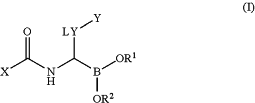| CPC C07F 5/025 (2013.01) [A61K 31/69 (2013.01); A61K 45/06 (2013.01); A61P 43/00 (2018.01)] | 16 Claims |
|
1. A method for treatment of an immunoregulatory abnormality or a cancer, the method comprising:
administering a compound of formula (I) tautomer, or stereoisomer thereof, as well as a pharmaceutically acceptable salt of each of the foregoing, including a mixture thereof in all ratios, to a patient in need thereof,
 wherein in the compound of formula (I):
LY denotes (CH2)m, wherein 1 to 4H atoms may be replaced by at least one selected from the group consisting of Hal, R3a, and OR4a; and/or wherein one CH2 group may be replaced by O, S, SO, or S2;
X denotes a heterobicycle or heterotricycle of formula (xa), (xb), (xc), (xd), (xe), (xf), (xg), (xh), or (xi); each, independently from one another, unsubstituted or mono-, di-, or trisubstituted by at least one selected from the group consisting of Hal, NO2, CN, R5a, OR5a, CONR5aR5b, NR5aCOR5b, SO2R5a, SOR5a, SO2NR5aR5b, NR5aSO2R5b, NR5aR5b, (CH2)q—R6, COR5a and/or SO2R5a; and wherein 1, 2 or 3 of the cyclic CH2 groups may be replaced by at least one selected from the group consisting of CR4aR4b, C═O, O, S, NR5a, SO and/or SO2;
 Y denotes P1, P2, or P3;
P1 denotes a linear or branched C1-C6-alkyl or C3-C8-cycloalkyl, each, independently from one another, unsubstituted or mono-, di-, tri-, or tetrasubstituted by at least one selected from the group consisting of Hal, CN, R3a, OR3a, and (CH2)q—R6;
P2 denotes phenyl or an aromatic monocyclic 5-, 6-, or 7-membered heterocycle, each unsubstituted or mono-, di-, tri-, tetra-, or pentasubstituted by at least one selected from the group consisting of Hal, CN, R3a, OH, OR3a, CONR4aR4b, NR3aCOR3b, SO2R3a, SOR3a, NR4aR4b, Ar2, Het2, (CH2)q—SR3a, (CH2)q—N(R4a)2, and (CH2)q—R6, wherein the heterocycle of P2 contains 1, 2, or 3 of N, O, and/or S atoms;
P3 denotes a bicyclic 8-, 9-, or 10-membered hydrocarbon or heterocycle, each independently from one another unsubstituted or mono-, di-, tri tetra-, or pentasubstituted by at least one selected from the group consisting of Hal, CN, R3a, OH, OR3a, CONR4aR4b, NR3aCOR3b, SO2R3a, SOR3a, NR4aR4b, Ar2, Het2, (CH2)q—SR3a, (CH2)q—N(R4a)2, and (CH2)q—R6, wherein at least one ring of the bicyclic hydrocarbon or heterocycle is aromatic, and wherein the heterocycle of P3 contains 1, 2, or 3 of N, O, and/or S atoms;
Cy1, Cy2, Cy3, Cy4 and Cy5 denote each, independently from one another, Ar1 or Het1;
R1 and R2 denote each, independently from one another, H or C1-C6-alkyl, or R1 and R2 form together a residue according to formula (CE):
 R3a and R3b denote each, independently from one another, linear or branched C1-C6-alkyl or C3-C8 cycloalkyl, wherein 1 to 5H atoms may be replaced by at least one selected from the group consisting of Hal, CN, OH, and OAlk;
R4a and R4b denote each, independently from one another, H or R3a; or R4a and R4b form together a C3-C8 alkylene group;
R5a and R5b denote each, independently from one another, H, R3a, Ar2, or Het2;
R6 denotes OH or OR3a;
T1, T2, T3, T4, T5, T6, T7, T8, and T9 denote each, independently from one another, O, SO, or C═O;
Alk denotes linear or branched C1-C6-alkyl;
Ar1 represents an aromatic 6-membered carbocycle;
Het1 represents a saturated, unsaturated, or aromatic 5- or 6-membered heterocycle having 1 to 4 of N, O, and/or S atoms;
Ar2 denotes phenyl, which is unsubstituted or mono- or disubstituted by at least one selected from the group consisting of Hal, NO2, CN, R3a, OR3a, CONHR3a, NR3aCOR3b, SO2R3a, SOR3a, NH2, NHR3a, N(R3a)2, and (CH2)q—R6;
Het2 denotes a saturated, unsaturated, or aromatic 5- or 6-membered heterocycle having 1 to 4 of N, O, and/or S atoms; which is unsubstituted or mono- or disubstituted by at least one selected from the group consisting of Hal, NO2, CN, R3a, OH, OR3a, CONHR3a, NR3aCOR3b, SO2R3a, NH2, NHR3a, N(R3a)2, (CH2)q—R6, and oxo (═O);
q denotes 1, 2, 3, 4, 5, or 6;
m denotes 0, 1, or 2; and
Hal denotes F, Cl, Br, or I;
wherein the immunoregulatory abnormality is an autoimmune or chronic inflammatory disease selected from the group consisting of systemic lupus erythematosus, chronic rheumatoid arthritis, inflammatory bowel disease, multiple sclerosis, amyotrophic lateral sclerosis, atherosclerosis, scleroderma, autoimmune hepatitis, Sjogren Syndrome, lupus nephritis, glomerulonephritis, Rheumatoid Arthritis, Psoriasis, Myasthenia Gravis, Immunoglobulin A nephropathy, Vasculitis, Transplant rejection, Myositis, Henoch-Schönlein Purpura, and asthma;
wherein the cancer is a hematological malignancy or a solid tumor,
wherein said hematological malignancy is a disease selected from the group consisting of multiple myeloma, mantle cell lymphoma, diffuse large B-cell lymphoma, plasmacytoma, follicular lymphoma, immunocytoma, acute lymphoblastic leukemia, chronic lymphocytic leukemia, and myeloid leukemia; and
wherein the solid tumor is selected from the group consisting of inflammatory breast and colon cancer, lung cancer, head and neck cancer, prostate cancer, pancreas cancer, bladder cancer, renal cancer, hepatocellular cancer, and gastric cancer.
|